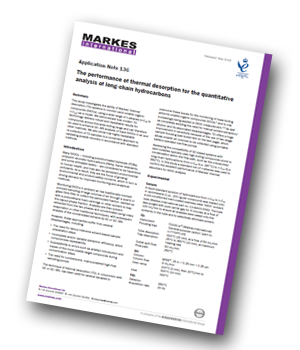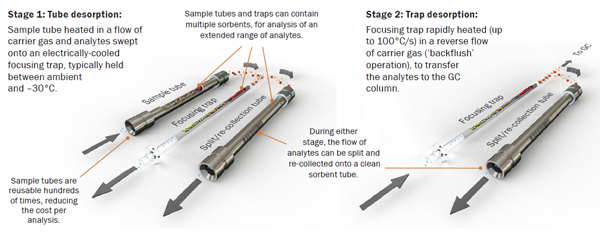This study investigates the ability of Markes’ thermal desorption (TD) systems to monitor semi-volatile organic compounds (SVOCs), using a wide range of n-alkanes (n-C16 to n-C44) as a model.

 Summary
Summary
The application note explains how modern TD technology delivers robust and repeatable results for compounds across this wide boiling range and can, therefore, be used to enhance GC–MS analysis of trace SVOCs in air and other matrices. It is also shown how highly repeatable re‑collection of TD samples is a convenient approach to validating analyte recovery in accordance with standard methods.
Introduction
Many SVOCs – including polychlorinated biphenyls (PCBs), polycyclic aromatic hydrocarbons (PAHs), flame retardants, and some phthalate esters – are considered to be hazardous to human health, and may also be persistent environmental pollutants. As a result, they are the focus of growing environmental and product-safety concerns, which in turn is driving demand for improved monitoring and analytical methods.
The technique of TD, in conjunction with GC or GC–MS, has been used for several decades to overcome issues that arise when monitoring lower-boiling airborne volatile organic compounds (VOCs), and is now increasingly being applied to SVOC measurement. As well as completely avoiding the need for manual solvent extraction/dilution and its associated disadvantages, TD offers a huge improvement in sensitivity because of the use of two-stage sample focusing, which allows smaller air volumes to be collected using portable battery-operated low-flow pumps.
Background to thermal desorption
Thermal desorption is a versatile, solvent-free pre‑concentration technique for gas chromatography that is used to analyse volatile and semi-volatile organic compounds (VOCs and SVOCs) in air/gas, liquids and solids. By concentrating organic analytes present in air (or released from a sample) into a very small volume of carrier gas in a two-stage process (see below), TD maximises sensitivity for trace-level target compounds, helps to minimise interferences, and routinely allows analyte detection at the ppb level or below. It also greatly improves sample throughput, by combining sample preparation, desorption/extraction, pre-concentration and GC injection into a single automated process.

Results and discussion
Desorption efficiency and analyte recovery
Markes’ TD systems (manual and automated) are unique in allowing samples to be split and quantitatively re-collected onto a clean sorbent tube at the tube desorption and/or trap desorption stages. Re-collected samples can then be re-analysed for validation of analyte recovery as described in key international standards. Quantitative re-collection of samples also overcomes the ‘one-shot’ limitation of traditional TD systems, and allows samples to be re-analysed under the same or different conditions – for example, with a selective detector or at a different split ratio to extend the dynamic range.
Conclusions
This study shows that Markes’ TD systems – and specifically the TD100-xr automated thermal desorber used here – provide highly predictable recovery and very low carryover for the analysis of long-chain alkanes ranging from n-C16 to n-C44.




